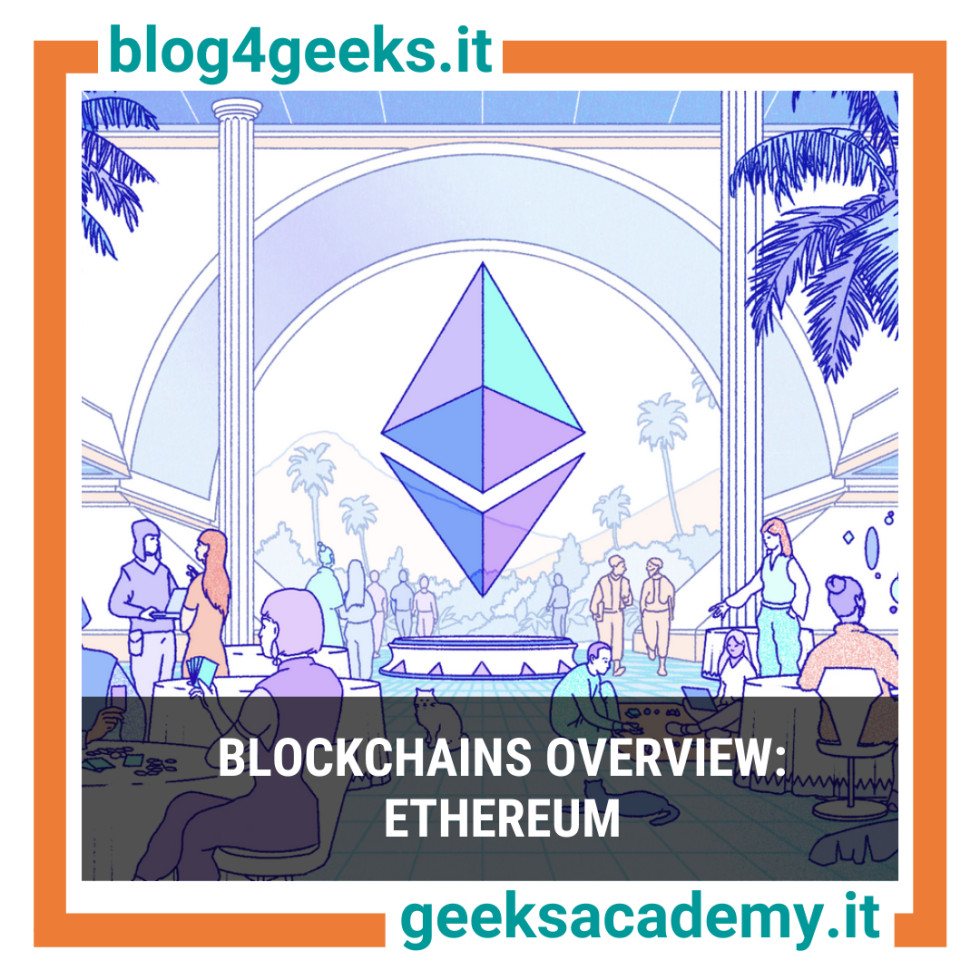
Discover Geeks Academy’s articles on: Blockchain, Coding, Cybersecurity, Cloud, Big Data, Artificial Intelligence, Gaming, Digital Innovation
Ethereum is the second largest cryptocurrency by market cap, which is approximately $458B, and has a supply of around $19B with more than 800,000 active addresses.
Ether and Ethereum, created in 2015 by a team led by Vitalik Buterin, Gavin Wood and Jeffrey Wilcke, three well-known folks within the crypto landscape, have become so fundamental for the development of the blockchain, so the analysts have been talking for several years now about a possible “flippening” between the market hierarchies.
Ethereum & the smart contracts revolution
The Ethereum project is known throughout the world for the innovative contribution it has brought to blockchain technology: smart contracts. Smart contracts are automated interactions of Boolean programs (which follow simple “if/when…then…” statements) extendable to any operation that requires a choice between two states. It was the introduction of smart contracts which gave birth to an important phenomenon: DeFi (Decentralized Finance). During the summer of 2020, the use of smart contracts for crypto financial transactions has indeed experienced a real boom, so much impact which has brought the Ethereum blockchain itself from a $10M TVL to a current total value locked of over $95B.
Beyond smart contracts: Ethereum’s key innovations
However, despite the constant growth of DeFi, it must be recognized that Ethereum has also brought much more than “just” smart contracts.
- Distributed Computing: Ethereum, also known as "Smart Chain", was indeed built to solve an extremely simple problem: database computing’s issue, which does need as requirement for individual hardware to operate efficiently on the web (and that requires an hardware so powerful for individuals, which only a few companies can afford). The second largest blockchain in the world has therefore contributed to the fruition of distributed computing, by creating a network in which each node can make its unused computing power available, allowing even those who do not have the capability to carry out large operations to use that shared resource and contribute to the network.
- EVM: EVM (Ethereum Virtual Machine) represents another major Ethereum innovation. This virtual machine simulates the operation of a single computer capable of executing OP_CODE instructions (low-level instructions translated into Solidity, Ethereum’s native language), so to give life to more complex executions, as the case of dApps and smart contracts, thus making Ethereum a programmable blockchain. Any interaction between a node and the EVM goes through Ether, Ethereum’s currency, which is called, in blockchain jargon, "gas". Gas’ smallest unit measure, known as "wei", serves not only as a reward to incentivize miners (similar to Bitcoin's network), but also to execute operations (which will require a certain amount of gas based on operations’ complexity), and as a bottleneck for those operations which lead to errors or loops (in order to discourage poorly written programs that could easily saturate the network).
- Account-based model: The main difference with Bitcoin lies in the model. Bitcoin uses the UTXO system, while Ethereum works with an account-based model. Therefore, we might think of an Ethereum node as a bank account in which transactions are linked to a balance to which a specific value is taken or added.
Ethereum’s strength
Currently, 90% of DeFi applications use the Ethereum Network for several reasons, including:
- longevity, as much stress testing have already carried out, so it provides greater security;
- market efficiency;
- interoperability, thanks to a huge number of projects developed on the EVM.
The Ethereum ecosystem is interoperable thanks to platforms such as Aave, Compound and MakerDao, which have allowed the rise of financial protocols’ first tools, such as stablecoins minting, collateralized loans, leverage and compound interests on savings/staking account.
Proof-of-Stake switching
Ethereum plays a crucial role in the crypto ecosystem. In order to further improve its efficiency and make the execution of smart contracts less expensive, the Ethereum network, after some major updates, has established, through a hard fork (protocol change), the transition from Proof-of-Work to Proof-of-Stake.
Proof-of-Stake switching is in a transitional phase, which should end in 2022 with the Merge of current Ethereum blockchain and the new Ethereum 2.0 chain (which will be discussed in a separate article).
Meanwhile, Ethereum.org has announced that, in order to prevent any confusion, the terms “Eth1” and “Eth2” will be respectively replaced by “execution layer” and “consensus layer”. However, the rebranding does not change the current roadmap.
Why you should learn blockchain?
DeFi, Agrifood, IoT, Sharing Economy, Insurance, Art, Gaming, Law. Blockchain’s use cases are endless, and understanding the way to make this technology even more efficient is just the beginning. One of the most relevant field of application is the industrial sector, where countless jobs of the future could theoretically be replaced by smart contracts, oracles and AI.
Blockchain’s skills are increasingly in demand. It is not too late to start your career now: blockchain is just becoming everyday life. However, the learning curve is still steep: many companies still cannot fully understand the difference between an usual database and a blockchain, so when they turn to business advisors, their use cases are often not suitable for the technology they want to use.
Here’s what it takes:
By checking different job vacancies, this is a list of the most relevant skills and requirements:
- Understanding of algorithms, data security, decentralized technologies and data structures.
- A solid background in coding skills, with at least one of the following programming languages: Python, JavaScript, Solidity, JAVA, C, C++.
- General understanding of ledgers, blockchains and cryptocurrencies.
- Expertise in performance management and anomaly detection.
- At least basic experience in building blockchain frameworks and business applications.
Don't live the future as a sidekick... be a superhero! Discover Geeks Academy’s training offer in Blockchain & Coding:
Blockchains Overview is an in-depth series about the most popular blockchains. Below a comprehensive list of the ones we have been talking about:
Fonti: